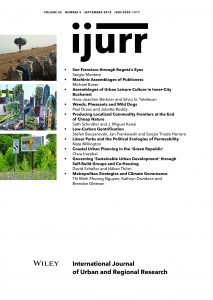Inner‐city redevelopment in the south‐eastern European metropolis of Bucharest has been an intriguing object of analysis. Having been neglected for a long time by its inhabitants, urban politics and the local economy, the historical inner city recently experienced tremendous development of its evening/night‐time economy and leisure culture, as though it had received fresh impulses from European integration. However, there is no single cause which effected this unexpected proliferation. Therefore, this article traces the contingent ways in which the inner city has been affected, mainly through an empirical reconstruction of socio‐material assemblages of inner‐city leisure culture. A typology of (partial) assemblages is developed, which illustrates the heterogeneity, contingency and changeability of emerging temporary relations between various social, material and ideational elements. We demonstrate how localism and internal replication of limited business concepts have triggered the selective adaptation of various symbols of modernization. Against this background we argue that post‐transformational urbanity involves contingent social self‐referencing and socio‐material assemblage, rather than the adoption of prevailing translocal models of urban development. A critical reassessment of assemblage theory, as applied to this particular urban context, leads to final considerations concerning possible theoretical readjustments.
Details
Written by:
Hans‐Joachim Bürkner & Silviu G. Totelecan
Digital Object Identifier (DOI)
10.1111/1468-2427.12630
About DOI

